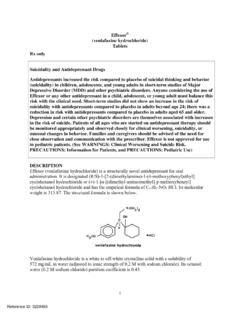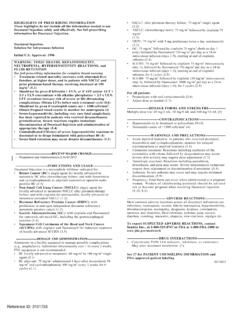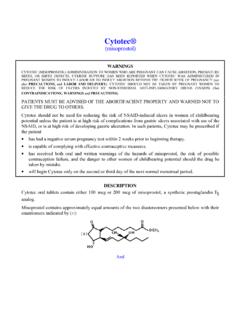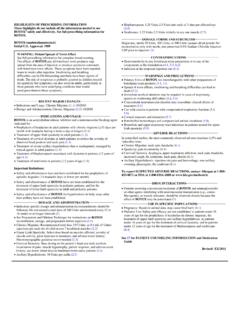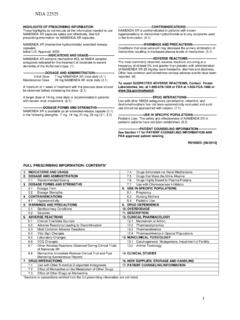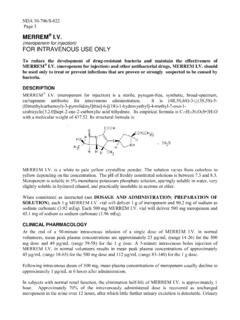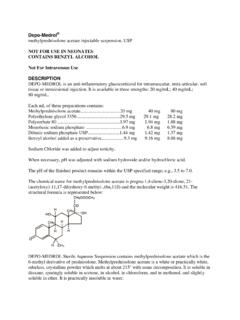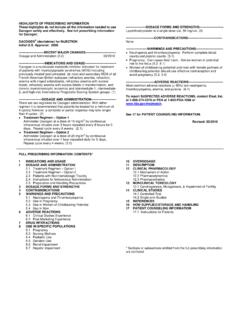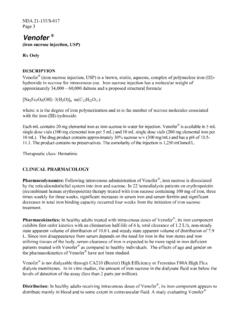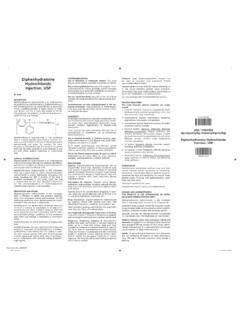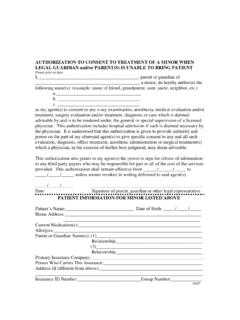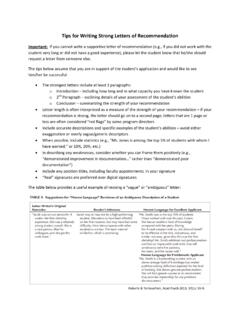Transcription of ZOFRAN (ondansetron hydrochloride) Label
1 HIGHLIGHTS OF PRESCRIBING INFORMATION These highlights do not include all the information needed to use ZOFRAN TABLETS, ZOFRAN ODT, and ZOFRAN ORAL SOLUTION safely and effectively. See full prescribing information for ZOFRAN TABLETS, ZOFRAN ODT, and ZOFRAN ORAL SOLUTION. ZOFRAN (ondansetron hydrochloride) tablets, for oral use ZOFRAN ODT (ondansetron) orally disintegrating tablets ZOFRAN (ondansetron hydrochloride) oral solution Initial Approval: 1991 ----------------------------INDICATIONS AND USAGE --------------------------- ZOFRAN is a 5- HT3 receptor antagonist indicated for the prevention of: nausea and vomiting associated with highly emetogenic cancer chemotherapy, including cisplatin greater than or equal to 50 mg/m2.
2 ( 1) nausea and vomiting associated with initial and repeat courses of moderately emetogenic cancer chemotherapy. (1) nausea and vomiting associated with radiotherapy in patients receiving either total body irradiation, single high-dose fraction to the abdomen, or daily fractions to the abdomen. (1) postoperative nausea and/or vomiting. (1) -----------------------DOSAGE AND ADMINISTRATION ---------------------- See full prescribing information for the recommended dosage in adults and pediatrics. (2) Patients with severe hepatic impairment: do not exceed a total daily dose of 8 mg. ( , ) ---------------------DOSAGE FORMS AND STRENGTHS -------------------- Tablets: 4 mg and 8 mg (3) Orally Disintegrating Tablets: 4 mg and 8 mg (3) Oral Solution: 4 mg/5 mL (3) -------------------------------CONTRAIND ICATIONS------------------------------ Patients known to have hypersensitivity ( , anaphylaxis) to ondansetron or any components of the formulation.
3 (4) Concomitant use of apomorphine. (4) ------------------------WARNINGS and PRECAUTIONS ----------------------- Hypersensitivity reactions including anaphylaxis and bronchospasm: Discontinue ZOFRAN if suspected. Monitor and treat promptly per standard of care until signs and symptoms resolve. ( ) QT interval prolongation and Torsade de Pointes: Avoid in patients with congenital long QT syndrome; monitor with electrocardiograms ( ECGs) if concomitant electrolyte abnormalities, cardiac failure or arrhythmias, or use of other QT prolonging drugs. ( ) Serotonin syndrome: Reported with 5-HT3 receptor antagonists alone but particularly with concomitant use of serotonergic drugs. If such symptoms occur, discontinue ZOFRAN and initiate supportive treatment. If concomitant use of ZOFRAN with other serotonergic drugs is clinically warranted, patients should be made aware of a potential increased risk for serotonin syndrome.
4 ( ) Masking of progressive ileus and/or gastric distention following abdominal surgery or chemotherapy-induced nausea and vomiting: Monitor for decreased bowel activity, particularly in patients with risk factors for gastrointestinal obstruction. (5. 4) Phenylketonuric patients should be informed that ZOFRAN ODT orally disintegrating tablets contain phenylalanine (a component of aspartame). Each 4-mg and 8-mg orally disintegrating tablet contains less than mg phenylalanine. ( ) ------------------------------ADVERSE REACTIONS ----------------------------- The most common adverse reactions in adults for the: prevention of chemotherapy-induced (greater than or equal to 5%) are: headache, malaise/fatigue, constipation, diarrhea. ( ) prevention of radiation-induced nausea and vomiting (greater than or equal to 2%) are: headache, constipation, and diarrhea.
5 ( ) prevention of postoperative nausea and vomiting (greater than or equal to 9%) are: headache and hypoxia. ( ) To report SUSPECTED ADVERSE REACTIONS, contact GlaxoSmithKline at 1-888-825-5249 or FDA at 1-800-FDA-1088 or See 17 for PATIENT COUNSELING INFORMATION. Revised: 10 /2016 FULL PRESCRIBING INFORMATION: CONTENTS* 1 INDICATIONS AND USAGE 2 DOSAGE AND ADMINISTRATION Dosage Dosage in Hepatic Impairment Administration Instructions for ZOFRAN ODT Orally Disintegrating Tablets 3 DOSAGE FORMS AND STRENGTHS 4 CONTRAINDICATIONS 5 WARNINGS AND PRECAUTIONS Hypersensitivity Reactions QT Prolongation Serotonin Syndrome Masking of Progressive Ileus and Gastric Distension Phenylketonuria 6 ADVERSE REACTIONS Clinical Trials Experience Postmarketing Experience 7 DRUG INTERACTIONS Serotonergic Drugs Drugs Affecting Cytochrome P-4 50 Enzymes Tramadol Chemotherapy Alfentanil and Atracurium 8 USE IN SPECIFIC POPULATIONS Pregnancy Lactation pediatric Use Geriatric Use Hepatic Impairment Renal Impairment 9 DRUG ABUSE AND DEPENDENCE 10 OVERDOSAGE 11 DESCRIPTION 12 CLINICAL PHARMACOLOGY Mechanism of
6 Action Pharmacodynamics Pharmacokinetics 13 NONCLINICAL TOXICOLOGY Carcinogenesis, Mutagenesis, Impairment of Fertility 14 CLINICAL STUDIES Prevention of Chemotherapy-induced Nausea and Vomiting Radiation-induced Nausea and Vomiting Postoperative Nausea and Vomiting 16 HOW SUPPLIED/STORAGE AND HANDLING 17 PATIENT COUNSELING INFORMATION * Sections or subsections omitted from the full prescribing information are not listed Reference ID: 4011596 FULL PRESCRIBING INFORMATION 1 INDICATIONS AND USAGE ZOFRAN is indicated for the prevention of nausea and vomiting associated with: highly emetogenic cancer chemotherapy, including cisplatin greater than or equal to 50 mg/m2. initial and repeat courses of moderately emetogenic cancer chemotherapy.
7 Radiotherapy in patients receiving either total body irradiation, single high-dose fraction to the abdomen, or daily fractions to the abdomen. ZOFRAN is also indicated for the prevention of postoperative nausea and/or vomiting. 2 DOSAGE AND ADMINISTRATION Dosage The recommended dosage regimens for adult and pediatric patients are described in Table 1 and Table 2, respectively. Corresponding doses of ZOFRAN tablets, ZOFRAN ODT orally disintegrating tablets and ZOFRAN oral solution may be used interchangeably. Table 1: Adult Recommended Dosage Regimen for Prevention of Nausea and Vomiting Indication Dosage Regimen Highly Emetogenic Cancer Chemotherapy A single 24-mg dose administered 30 minutes before the start of single-day highly emetogenic chemotherapy, including cisplatin greater than or equal to 50 mg/m2 Moderately Emetogenic Cancer Chemotherapy 8 mg administered 30 minutes before the start of chemotherapy, with a subsequent 8-mg dose 8 hours after the first dose.
8 Then administer 8 mg twice a day (every 12 hours) for 1 to 2 days after completion of chemotherapy. Radiotherapy For total body irradiation: 8 mg administered 1 to 2 hours before each fraction of radiotherapy each day. For single high-dose fraction radiotherapy to the abdomen: 8 mg administered 1 to 2 hours before radiotherapy, with subsequent 8-mg doses every 8 hours after the first dose for 1 to 2 days after completion of radiotherapy. For daily fractionated radiotherapy to the abdomen: 8 mg administered 1 to 2 hours before radiotherapy, with subsequent 8-mg doses every 8 hours after the first dose for each day radiotherapy is given. Postoperative 16 mg administered 1 hour before induction of anesthesia . Reference ID: 4011596 Table 2: pediatric Recommended Dosage Regimen for Prevention of Nausea and Vomiting Indication Dosage Regimen Moderately Emetogenic Cancer Chemotherapy 12 to 17 years of age: 8 mg administered 30 minutes before the start of chemotherapy, with a subsequent 8-mg dose 4 and 8 hours after the first dose.
9 Then administer 8 mg three times a day for 1 to 2 days after completion of chemotherapy. 4 to 11 years of age: 4 mg administered 30 minutes before the start of chemotherapy, with a subsequent 4-mg dose 4 and 8 hours after the first dose. Then administer 4 mg three times a day for 1 to 2 days after completion of chemotherapy. Dosage in Hepatic Impairment In patients with severe hepatic impairment (Child-Pugh score of 10 or greater), do not exceed a total daily dose of 8 mg [see Use in Specific Populations ( ), Clinical Pharmacology ( )]. Administration Instructions for ZOFRAN ODT Orally Disintegrating Tablets Do not attempt to push ZOFRAN ODT tablets through the foil backing. With dry hands, PEEL BACK the foil backing of 1 blister and GENTLY remove the tablet. IMMEDIATELY place the ZOFRAN ODT tablet on top of the tongue where it will dissolve in seconds, then swallow with saliva.
10 Administration with liquid is not necessary. 3 DOSAGE FORMS AND STRENGTHS ZOFRAN tablets are oval, film-coated tablets engraved with ZOFRAN on one side and are available in the following strengths: 4 mg white tablet with 4 engraved on the other side. 8 mg yellow tablet with 8 engraved on the other side. ZOFRAN ODT orally disintegrating tablets are white, round, and plano-convex tablets available in the following strengths: 4 mg debossed with Z4 on one side. 8 mg debossed with Z8 on one side. ZOFRAN oral solution, 4 mg/5 mL, is a clear, colorless to light yellow liquid with a characteristic strawberry odor available in a 50-mL bottle. 4 CONTRAINDICATIONS ZOFRAN is contraindicated in patients: known to have hypersensitivity ( , anaphylaxis) to ondansetron or any of the components of the formulation [see Adverse Reactions ( )].
